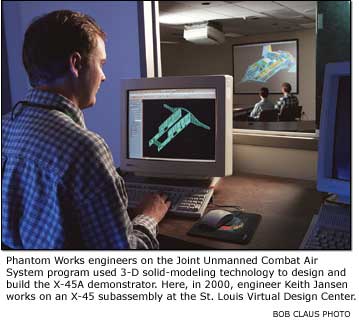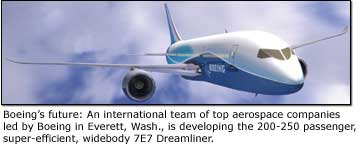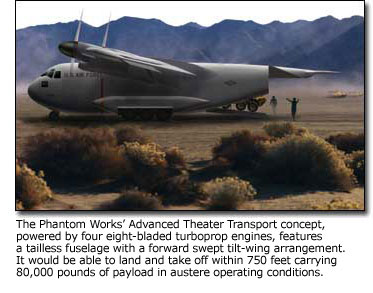| Engineering's gifts
to the world
Boeing
engineers and technologists
envisioned and designed products
that changed life in the 20th century.
Look for them to do more amazing things
the next 100 years.
BY WILLIAM COLE
What do a climber lost in the Himalayas,
a family flying to Europe for a vacation, and a hurricane victim
in Puerto Rico have in common? They live in a world made better—and
safer—by Boeing engineers and technologists.
 Consider
how Boeing experts have changed the way people work, travel and
relax. Guided by satellites 10,900 miles above Earth, the lost mountaineer
can find his or her bearings with the now-commonplace Global Positioning
System built and launched by Boeing. Today, even motorists are guided
to their destinations by GPS. Consider
how Boeing experts have changed the way people work, travel and
relax. Guided by satellites 10,900 miles above Earth, the lost mountaineer
can find his or her bearings with the now-commonplace Global Positioning
System built and launched by Boeing. Today, even motorists are guided
to their destinations by GPS.
The family going
on vacation to Europe is flying on a 777 twin-aisle jetliner designed
and built by Boeing employees in Everett, Wash. Technology advances
and streamlined production processes have made overseas travel
safer, faster and more affordable and routine for travelers around
the world.
The C-17 Globemaster III military transport plane, designed and
built by employees in Long Beach, Calif., has rescued Americans from
war-torn
Liberia and dropped vital supplies to hurricane victims in Puerto
Rico and other parts of the Caribbean. C-17s also played key roles
in Operation Enduring Freedom, the military response to the Sept. 11,
2001 terrorist attacks on the United States and, subesequently Operation
Iraqi Freedom.
The 20th century saw the introduction and refinement of
spacecraft, and incredible advancements in commercial and
military aircraft. Boeing engineers and technologists were
involved in all of them.
"Boeing engineers and technologists shrank the world and brought people together
in the 20th century," said Dave Swain, chief operating officer for Integrated
Defense Systems, a 39-year veteran of Boeing and an established advisor to both
government and industry on aerospace issues. "What they did was nothing short
of miraculous."
During the last 30 years, Boeing engineers and technologists
have made space travel possible. They designed and produced the vehicles that
pioneered the first orbits around Earth, landed Americans on the moon and brought
them
home safely. Today, engineers are sending cameras and instruments to probe
the farthest reaches of the universe. They are working on the next
generation of reusable launch
vehicles. And astronauts aboard the International Space
Station are conducting experiments that could someday save
millions of people from serious disease.
Boeing employees have opened the world to travelers
of all nations. Each day, 3 million passengers board 42,300
flights on Boeing commercial jetliners. As they travel, they
can work on laptops, watch movies or listen to music. Soon
they will be able to surf the Internet and access e-mail aloft.
Military aircraft that Boeing employees helped design and
build played a major role in winning World War II, and today
are playing a major role in defending freedom—and delivering
help—around the world. Large-scale systems-of-systems are creating a new integrated
battlespace that will shorten conflicts and protect allied forces. Advanced
unmanned systems
will carry out many of the dangerous, dull and dirty
missions of future conflicts.
But the story of Boeing innovations doesn't end with the
20th century. Thanks to forward-thinking engineers and technologists,
Boeing will play a crucial role in how people will
communicate, travel, and defend their nations in the future. A HISTORY OF INGENUITY AND PERSISTENCE
Shakespeare wrote that what's past is prologue.
Boeing's past achievements provide a solid foundation
for its future. Nevertheless, some of the
company's greatest engineering triumphs had
humble beginnings.
The legendary B-52 bomber, for example,
was conceived in 1948 in a Dayton, Ohio, hotel.
Six Boeing engineers were stung when U.S. Air Force representatives, unimpressed
with their proposal for a long-range turboprop bomber, sent them
packing.
But instead of giving up, the engineers bought balsa wood,
glue and a knife at a local hobby shop and returned to their
hotel. There, they fashioned a model of a jet-powered superbomber,
spent a couple of bleary nights completing a 33-page
proposal, and went back to their customer. The Air Force
was delighted with the new concept. The B-52 was born and
is still in service. And Boeing still proudly displays in its
archives in Seattle the balsa-wood plane that started it all.
 Similar
ingenuity produced the heroic P-51 Mustang of World War II fame.
North American Aviation engineers created the aircraft after their
customer, the British Purchasing Commission, instructed them to
buy the Curtiss Company design data for the P-40 and replicate it
for the Royal Air Force. Lee Atwood, the legendary engineer, did
indeed pay $56,000 for the data, but he didn't even take the blueprints
out of the box. He and his team had a better idea, one that would
not only meet but also exceed the requirements. The team built the
far-superior Mustang, which went on to claim more than half the
enemy aircraft shot down over Europe during World War II. Similar
ingenuity produced the heroic P-51 Mustang of World War II fame.
North American Aviation engineers created the aircraft after their
customer, the British Purchasing Commission, instructed them to
buy the Curtiss Company design data for the P-40 and replicate it
for the Royal Air Force. Lee Atwood, the legendary engineer, did
indeed pay $56,000 for the data, but he didn't even take the blueprints
out of the box. He and his team had a better idea, one that would
not only meet but also exceed the requirements. The team built the
far-superior Mustang, which went on to claim more than half the
enemy aircraft shot down over Europe during World War II.
"Those engineers were absolutely dedicated," said Erik Simonsen,
Boeing historian and Air Force Systems
communications manager. "They were the kind who would not be deterred by short-term
disappointments on their way to their ultimate goal: to build an aircraft that
was better than anything else existing at the time."
McDonnell engineers discovered
the truth of Henry Ford's theory that much of success counts on being prepared.
Because they had researched and developed technologies for
an unsolicited manned spacecraft a full year before NASA
invited bids for the Mercury program, McDonnell won the
contract and earned a leading role in the space race.
McDonnell engineers exhibited another attribute commonly promoted
at leadership seminars: the ability to learn from failure. In the
early 1950s, they turned a rejection of their twin-engine variant
of the F3H Demon into a masterpiece: the F-4 Phantom II. After the
Pentagon turned down the twin-engine proposal, McDonnell engineers
went out to talk to U.S. Navy pilots to find out exactly what their
dream plane would be. Using that information and its own money, McDonnell
submitted a new, unsolicited proposal. The Navy was impressed, and
in 1954 it ordered two F-4 prototypes. The Phantom's performance
and reliability were so good that it served simultaneously with the
Navy, Marine Corps and Air Force, as well as for several allied countries.
It was a
combat workhorse in Vietnam.
"Today, we'd call that "thinking outside the box,'" said Larry
Merritt, Boeing St. Louis historian. "These engineers were true innovators
who were encouraged to think differently in freewheeling brainstorming
sessions. They went in
directions that nobody else had taken before."
 THE
PIONEERS OF THE IMPOSSIBLE THE
PIONEERS OF THE IMPOSSIBLE
Engineering achievements by the companies that now constitute Boeing
have dazzled the world for 95 years.
"Boeing engineers and technologists
applied their knowledge and skills to convert matter and energy into
things
that are tremendously useful to humanity," Swain said, "things that make our
lives more comfortable, more enjoyable, healthier, safer and more secure. Boeing
engineers and technologists will help shape the world in the 21st century. This
will require tremendous innovation. But once we dream it, we can build it. Why?
Because we employ some of the
brightest people on the planet."
Mike Lombardi, Boeing chief historian, said
Boeing engineers
have triumphed because they refuse to be influenced by
naysayers.
"They are the pioneers of doing the impossible and making
it commonplace," he said. "The skeptics told us that the 747 would never get
off the ground. They told us that putting a man on the moon was impossible.
Well, the 747 has flown 35 billion statute miles, enough to make 74,000 trips
to the
moon and back. And we not only put men on the moon, the Boeing heritage companies
built the first, second, and third stages of the Saturn V booster rocket, the
Saturn engines, the Apollo vehicle, and, later, the Lunar Rover. That can-do
spirit
will mark the next 100 years. We're venturing into new territories
with new technologies. And this is just the start. We
can do anything we want to do."
The Boeing Company, once called a "scrappy innovator" by
The Wall Street Journal, is doing just that: taking another
chance on the future.
WHAT DREAMS MAY COME
The Boeing tradition of bold innovation continues
into the 21st century. The company set its sights on being part
of the global economy, and it is already there. Boeing Air Traffic
Management
is introducing revolutionary concepts to solve the congestion problems
that come with expanded travel. Connexion by Boeing is creating
an office in the sky for airline passengers.
Boeing engineers are
also
blending platforms and other products into large systems-of-systems
to create an integrated battlespace. The U.S. Army's Future Combat
Systems, for example, integrates networked information and communications
systems to offer an advantage to soldiers in the field and commanders
in the control room. It also features a combination of manned
and unmanned systems, airplanes, tanks, vehicles, and intelligence-gathering
drones and robotic systems that improve survivability while reducing
the time and cost of combat operations.
And Boeing is leveraging
its core competencies and intellectual
capital to provide safer, more affordable air travel to
the world in such airplanes as the 7E7 Dreamliner.
 In
conversations with engineering students, Swain often discusses nanotechnology,
a process for building systems at the molecular level. He predicts
that engineers will soon bring to the world devices that were once
the stuff of science fiction: materials with integrated sensors
that allow products to "heal" themselves, military systems-of-systems
that could end conflicts in just hours with no loss of life, and
transportation systems that could take tourists into space. Boeing
technology leaders are working on X-vehicle programs that could
lead to scramjet-powered travel at speeds of up to Mach 10. And
one day people may be using personal air vehicles much as they use
cars today. In
conversations with engineering students, Swain often discusses nanotechnology,
a process for building systems at the molecular level. He predicts
that engineers will soon bring to the world devices that were once
the stuff of science fiction: materials with integrated sensors
that allow products to "heal" themselves, military systems-of-systems
that could end conflicts in just hours with no loss of life, and
transportation systems that could take tourists into space. Boeing
technology leaders are working on X-vehicle programs that could
lead to scramjet-powered travel at speeds of up to Mach 10. And
one day people may be using personal air vehicles much as they use
cars today.
THE NEXT
GENERATION
To make these dreams come true, Boeing now must develop a generation
of engineers and technologists who can meet the new challenges of
the 21st century.
"We have to talk about our accomplishments and
what our
products mean in a world setting," Swain said. "We need to convince this next
generation of engineers that they can help make Earth a better place to live.
We have to make sure that
the future is in good hands.
"In the long run, despite business fluctuations,
we have to believe that engineering is going to be as important and exciting
in this century as it was in the last.
"We are at the dawning of a new age."
| 
